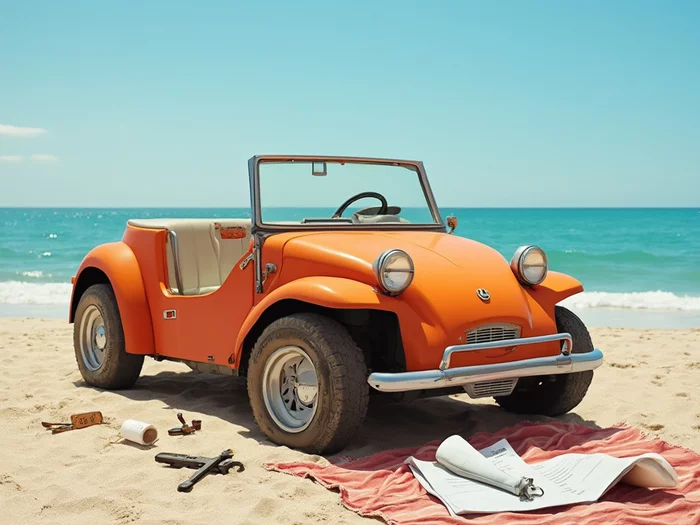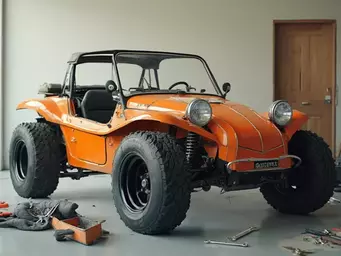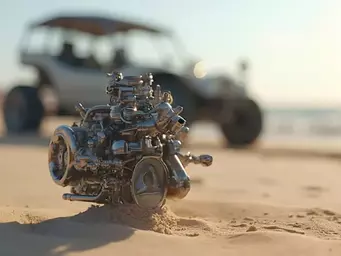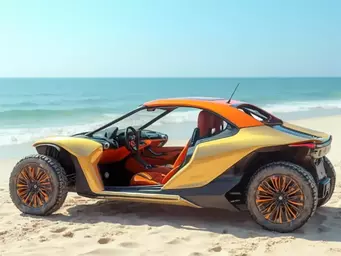Initial Purchase: $1,000 - $5,000
Varies based on condition, rarity, and location.
(e.g., rusted classic vs. newer model)
Get the latest beach buggy build guides, restoration tips, and performance upgrades delivered directly to you.
Posted on: 2025-10-11
By: Jasper Quinn
As you embark on a beach buggy restoration project, it’s essential to understand the costs involved. Did you know that proper budgeting can prevent those dreaded surprise expenses? Let's break down the key financial aspects you'll encounter on your journey!
A comprehensive look at the financial aspects and considerations for restoring your beach buggy.
Varies based on condition, rarity, and location.
(e.g., rusted classic vs. newer model)
Rust repair and paintwork.
(Depends on damage extent & finish desired)
Tune-ups to complete overhauls.
(Parts replacement, upgrades)
New seats, upholstery, dashboard.
(Materials & modifications)
Upgrades/repairs for performance & safety.
(Shocks, springs, electrical checks)
For professional specialized work.
(Varies by complexity & expertise)
Engine rebuilds, transmission, brakes.
(Essential for smooth operation)
Local requirements for modifications.
(Avoid future headaches)
For unexpected issues or parts.
(Crucial for peace of mind)
When diving into a beach buggy restoration project, understanding the cost breakdown is crucial. It not only helps you prepare financially but also ensures you prioritize your efforts effectively. Let's explore the key expense categories you'll need to consider to make your restoration journey smoother and more enjoyable!
The first expense you’ll encounter is the initial purchase price of your beach buggy. Whether you find a rusted classic or a newer model, the price can fluctuate significantly based on condition, rarity, and location. In Australia, you might find great deals on vintage models that can be restored to their former glory. Be prepared for a range of prices, typically between $1,000 and $5,000, depending on what you choose!
Here’s a quick checklist for evaluating your potential purchase:
Taking these steps will help you gauge whether the initial price aligns with your budget and restoration plans.
Next up, let’s talk about bodywork costs. It's common for beach buggies, especially older models, to show signs of rust. Repairing these issues is essential for both aesthetics and safety. Depending on the extent of damage, you might spend anywhere from $500 to $2,500 on rust repair and paintwork. Remember, a fresh coat can also enhance your buggy's appeal!
When budgeting for bodywork, consider these factors:
By understanding these aspects, you'll set realistic expectations for your restoration project.
The heart of your beach buggy is its engine. Refurbishing it can range from simple tune-ups to complete overhauls, depending on your engine’s condition. Budgeting for engine refurbishment might cost between $1,000 and $4,000. This investment will greatly affect your buggy's performance on sandy terrains!
Keep in mind these key components when planning your engine refurbishment:
Make sure to allocate a portion of your budget for this essential step!
Don’t forget about the interior! A comfortable and aesthetically pleasing interior can enhance your overall driving experience. For a full interior refresh, expect to spend around $500 to $2,000. This could include new seats, upholstery, and dashboard upgrades.
Consider these elements when budgeting:
Investing in the interior will make every beach ride a pleasure!
The suspension and wiring systems are crucial for both performance and safety. Upgrading or repairing these components can cost anywhere from $750 to $3,000. A reliable suspension will handle the rough terrains typical in beach environments, while well-functioning wiring ensures all electrical components perform seamlessly.
Here are some key points to consider for these systems:
Understanding these components will help you craft a more comprehensive budget for your restoration project.
One of the biggest decisions you'll face is whether to tackle the restoration yourself or hire professionals. Both options have their pros and cons, and understanding these can help you make an informed choice!
Opting for a DIY restoration can lead to significant savings. You'll have the chance to learn new skills while also keeping costs low. You may end up spending about 50% less than hiring pros, especially if you already have some tools and experience. Plus, the satisfaction of completing a project yourself is unmatched!
Before diving in, consider:
If you're ready to roll up your sleeves, you can save a lot while enjoying the process!
There are times when hiring a professional is the best route. If the project involves extensive bodywork, electrical systems, or complex mechanical repairs, it might be worth the extra expense. Professionals provide expertise and can often complete tasks more quickly and efficiently.
Think about these factors when deciding:
Making the right choice here can save you both time and money in the long run.
Having a detailed cost estimate is essential to prevent surprises down the road. Knowing what to expect can help you stick to your budget and avoid overspending.
Labor costs can eat into your budget quickly, especially if you hire professionals for specialized work. Depending on the complexity, labor rates can range from $50 to $150 per hour. Be sure to factor in these rates when planning your budget.
Ask yourself:
Having a clear idea of labor expectations can keep your project on track.
Mechanical work is vital for ensuring your beach buggy runs smoothly. Services like engine rebuilds, transmission repairs, and brake replacements can be costly. Budget for these expenses, which can range from $500 to $5,000 depending on what you need.
Consider these key services when estimating costs:
Understanding these elements will give you a clearer picture of your overall expenses.
Lastly, don't forget about permits and regulations. Depending on your location, you may need permits for certain modifications, which can add additional costs. Budget around $200 to $500 for these necessities.
Keep in mind:
Taking care of the legal side will help you avoid headaches later!
The total cost can vary significantly based on the buggy's initial condition, the extent of restoration, and whether you opt for DIY or professional services. Generally, a full restoration can range from $5,000 to over $15,000, not including the initial purchase price.
Key expense categories include the initial purchase price ($1,000-$5,000), bodywork ($500-$2,500), engine refurbishment ($1,000-$4,000), interior refresh ($500-$2,000), suspension and wiring ($750-$3,000), mechanical work ($500-$5,000), labor costs ($50-$150/hr for professionals), and permits/regulations ($200-$500). A contingency fund of 10-20% is also recommended.
Yes, DIY restorations can save you approximately 50% compared to hiring professionals. This requires a good skill level, access to tools, and a willingness to invest your own time.
It's advisable to hire professionals for complex tasks such as extensive bodywork, intricate electrical systems, or major mechanical repairs if you lack the necessary skills, tools, or time. Professionals can ensure quality and efficiency, potentially preventing costly mistakes.
A contingency fund (typically 10-20% of your total budget) is crucial for covering unexpected issues or parts that might arise during the restoration process. It provides peace of mind and helps prevent budget overruns.
Creating a budget plan is like having a roadmap for your restoration journey. It helps you stay organized and focused on your goals, ensuring you don’t overlook important expenses.
Consider a phased budget approach that allows you to prioritize essential projects first. For instance, you might focus on mechanical work before diving into aesthetic upgrades. This strategy helps you manage costs effectively and avoids overwhelming yourself!
Think about these phases:
By breaking it down, you can tackle each stage confidently!
Always plan for the unexpected! It's wise to set aside a contingency fund—typically around 10-20% of your budget—for any surprises that might arise during the project. This fund can cover additional repairs or parts you didn’t anticipate needing.
Ask yourself:
Having this safety net will give you peace of mind while you work!
Finally, consider cost-saving strategies when sourcing parts. Shopping around, looking for used parts, or even building your own components can help you save money. Websites like eBay, forums, and local clubs can be great resources for finding deals!
Here are some tips for sourcing:
Being resourceful can significantly cut down your expenses while ensuring a successful restoration!
Seeing real-life examples can shed light on what to expect for your own project. Let's analyze some case studies of beach buggy restorations to better understand costs.
Imagine restoring a classic beach buggy for under $5,000! In this example, the owner sourced a $1,500 model needing minimal engine work and focused on DIY body repairs and a fresh paint job for around $1,000. By prioritizing and being resourceful, they achieved an impressive restoration within budget. This shows what’s possible with careful planning!
On the flip side, high-end restorations can easily exceed $15,000. For example, a full custom build with top-of-the-line parts, professional labor, and unique designs can add up quickly. Understanding these possibilities will help you set realistic expectations based on your goals!
Visual aids can enhance your understanding of costs associated with your restoration. Utilizing infographics and tables can help you visualize the financial aspects of your project!
Infographics are a fantastic way to represent how different costs break down in a restoration project. They can highlight major categories like labor, parts, and additional expenses, making complex data easier to digest!
Creating tables offers a clear comparison of expenses between DIY and professional restoration. This visual representation can help in deciding which route to take!
Finally, don’t overlook the essential resources that can aid your restoration project. Having the right materials, tools, and support can make all the difference!
Finding reliable suppliers is crucial for sourcing quality materials and parts. Research local and online suppliers like VW Heritage that specialize in beach buggies for the best options!
Investing in the right tools is vital for any DIY restoration. Basic tools like wrenches, screwdrivers, and a good quality paint sprayer will go a long way!
Don't forget the power of community! Join online forums and social media groups dedicated to beach buggies. Sharing experiences and tips can be incredibly valuable for your restoration journey.
When sourcing parts for your beach buggy restoration, consider joining local beach buggy clubs or online forums. Not only can you find great deals on used parts, but you can also gain valuable insights and tips from other enthusiasts who have faced similar challenges. Networking within the community can lead to more cost-effective solutions and enhance your restoration experience!
After diving deep into the financial aspects of beach buggy restoration, it's crucial to take a step back and summarize your budget planning. This summary will not only help you keep track of your expenses but also prepare you for the journey ahead. Remember, every dollar counts when it comes to turning your dream buggy into a reality!
As you finalize your budget, it’s essential to consider long-term maintenance costs. Restorations don't end once the project is complete; regular upkeep can help you avoid costly surprises down the road. So, let’s break this down!
When budgeting for beach buggy restoration, it’s wise to incorporate a forecast of your long-term maintenance costs. This allows you to enjoy your beach buggy without the stress of unexpected expenses. Key areas to consider include:
By planning for these costs, you’ll be better equipped to maintain your beach buggy in top condition. It’s all about ensuring your ride is as fun after restoration as it is during those first joyful drives along the coast!
Now that you have a solid grasp of your budget, it’s time to prepare for your restoration journey. Here are some practical next steps to guide you:
These steps will set a solid foundation for your restoration project and ensure you stay organized throughout the process. Plus, sharing your objectives with the Beach Buggy Builders community can open doors to valuable insights and connections!
To make your budgeting even easier, we’re excited to offer a downloadable budget template. This tool can help you track your expenses, manage your spending, and keep everything organized. You can find it on our website, ready to assist you in crafting your perfect budget!
As you embark on your restoration journey, having the right resources at your fingertips is essential. Here are some recommended resources:
These resources will empower you, keep the excitement alive, and ensure you have the support you need throughout your project.
Lastly, managing your expectations regarding project timelines is vital for a smooth restoration process. Here are some aspects to consider:
By planning for these elements, you’ll be set for a rewarding restoration experience. Remember, here at Beach Buggy Builders, we’re with you every step of the way, cheering you on as you turn your project into a stunning beach buggy ready for adventure!
Here is a quick recap of the important points discussed in the article:

 What if every turn of the wrench not only transformed your beach buggy but also deepened your passio
What if every turn of the wrench not only transformed your beach buggy but also deepened your passio
 Upgrading your beach buggy isn't just about power—it's a journey towards better performance and en
Upgrading your beach buggy isn't just about power—it's a journey towards better performance and en
 Have you ever felt the thrill of cruising along the shore in a custom beach buggy, the sun warming y
Have you ever felt the thrill of cruising along the shore in a custom beach buggy, the sun warming y